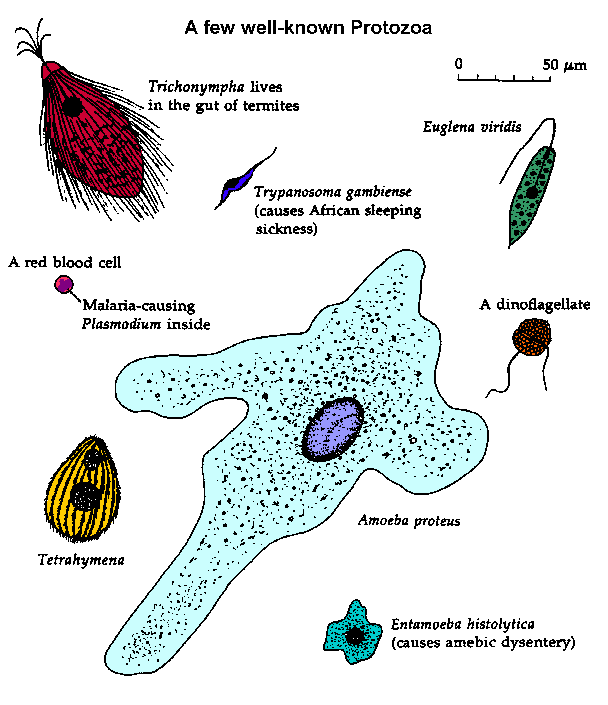

The ameba, as exemplified by Amoeba proteus and Entamoeba histolytica, are amorphous and continuously change their shape as they move by extending portions of their body. These extensions are called pseudopodia (false feet) and this type of movement is called ameboid movement. The common Amoeba proteus is found on decaying vegetation at the bottom of freshwater streams and ponds. Entamoeba histolytica inhabits the human colon and can cause dysentery and other severe disease.
In contrast to the ameba, some protozoa are relatively rigid in their morphology. Many ciliates, such as Tetrahymena, have a 'cytoskeleton' underlying their plasma membranes. This cytoskeleton is composed of long rows of microtubules which dictate their shape. Movement in the ciliates is accomplished through the action of cilia which cover the surface of the organism and function somewhat like oars. The ciliates are also noted for a nuclear dimorphism and their sexual reproduction involving the exchange of DNA during conjugation.
Another organelle used by numerous protozoa for movement is the flagellum (see protozoan motility). Flagella are equivalent to cilia except that they tend to be longer and are generally fewer in number. Movement is accomplished through a whip-like action of the flagella. Protozoa exhibiting flagella are collectively called flagellates. However, this is a very diverse group and does not reflect phylogenetic relationships.
Euglena are a prototypic flagellate with a single flagellum emerging from one end. The euglenoids are also claimed by phycologist and botanist as being algae since they have chloroplasts and are notably green (see taxonomy). Flagella can also be modified. For example, the membrane enclosed flagellum can fold back along the body of the organism and form an 'undulating membrane'. This undulating membrane is a fin-like structure which greatly enhances mobility. Many members of the kinetoplastids, a sister group to the euglenoids, exhibit an undulating membrane during their life cycle. Trypanosoma gambiense is just one of the kinetoplastid species which cause human disease.
Dinoflagellates are bi-flagellar organisms most often associated with being a component of plankton. Some dinoflagellates secrete 'shells' giving them an armored appearance. Non-photosynthetic plastids (related to chloroplasts) found in some dinoflagellates result in a variety of colors. Under favorable conditions dinoflagellates will reproduce to high levels producing an 'algae bloom', also called 'red tides'. Some dinoflagellates excrete toxins which result in massive fish kills during red tides.
In contrast to the usual expression of 1-5 flagella, Trychonympha are covered with numerous flagella. This organism is a symbiont living in the gut of termites. Trychonympha with the assistance of a symbiont bacteria living in its cytoplasm, digests cellulose for the termite. The protozoa and termite are completely co-dependent on each other for their mutual survival.
Symbiotic relationships are not always mutually beneficial. Many protozoa are parasites which harm their hosts. The malaria parasite lives inside of red blood cells ultimately resulting in their destruction. The parasite exhibits a very complex life cycle involving transmission by mosquitoes. Plasmodium falciparum is estimated to infect several hundred million people every year and several million will die from complications associated with the disease.